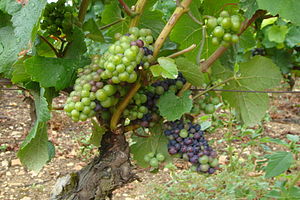Elements of Wine 6: Oak
Ageing a wine in oak barrels has two main effects. The first is to imbue the wine with flavour and aroma compounds from the wood. This occurs most notably when the wine is matured in barriques (225 litre barrels) made from ‘new’ oak. New oak means the barrels have not been used before for ageing wine, thus there is a higher concentration of flavour molecules to impart to the wine. Wines aged in new oak typically develop notes of butter, toast, nuts, spice, or – if the wine has been aged in American, rather than French oak – coconut and white chocolate.

- Oak barriques for the maturation of red wineJim Nix / Nomadic Pursuits / Foter / CC BY-NC-SA
The second effect of oak maturation expresses itself structurally in the wine. Oak barrels, while impermeable to liquid, still allow a small amount of air into the wine. This air exchange allows for a very slight oxidation of the wine, an effect that can be controlled by the size of the barrel and the length of time the wine spends inside. As well as changing the colour of the wine (white wines deepen and red wines lighten) this natural micro-oxygenation ‘softens’ the wine, giving a rounder, fuller, creamier mouth-feel. Red wines also benefit from their tannins polymerising and becoming less harsh, thus integrating better into the body of the wine. Oak barrels are also often conducive to the conversion of malic acid to lactic acid.

- Large oak vessels are also used as vinification vats.theqspeaks / Foter / CC BY-NC-SA
Old oak barrels – that is barrels which have been already used at least once to mature wine – give the benefit of the oxygen exchange with the wine without the transferal of wood flavours. It can thus be difficult to detect the use of old oak on the palate; although look out for more density on the palate and a harmonious integration of fruit flavours, body and tannin.
Sign up for Jonell Galloway and James Flewellen’s “Celebrate the Chartres Festival of Lights & Autumnal Equinox with a Food & Wine Tasting Masterclass” in France from September 19 to 22, 2013.
__________________
Dr James Flewellen is The Rambling Epicure wine columnist. James is a biophysicist at the University of Oxford. Originally from New Zealand, James learned his trade in taste through the Oxford Blind Wine Tasting Society, of which he was the President from 2010-2012. During his term, he represented Oxford at many international blind tasting competitions – twice winning the prestigious ‘Top Taster’ Award in the annual Varsity blind tasting match against Cambridge University and captaining winning teams in competitions throughout Europe.
James runs wine education courses in Oxford through the Oxford Wine Academy and is completing the WSET Professional Diploma in Wine and Spirits. He is the founder of The Oxford Wine Blog and co-author of the forthcoming book: The Concise Guide to Wine and Blind Tasting.
Related articles

|
|



 by Vendange
by Vendange





















